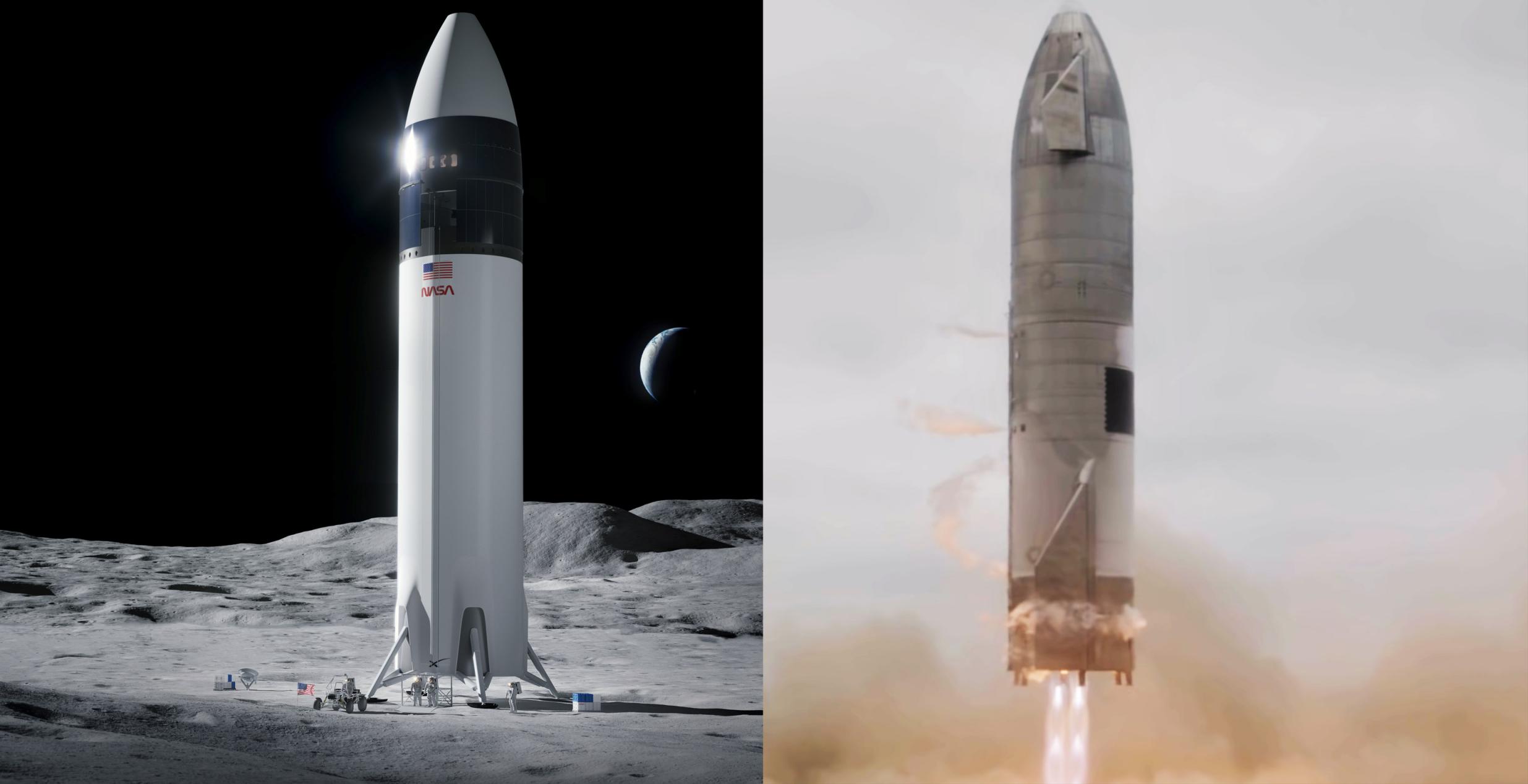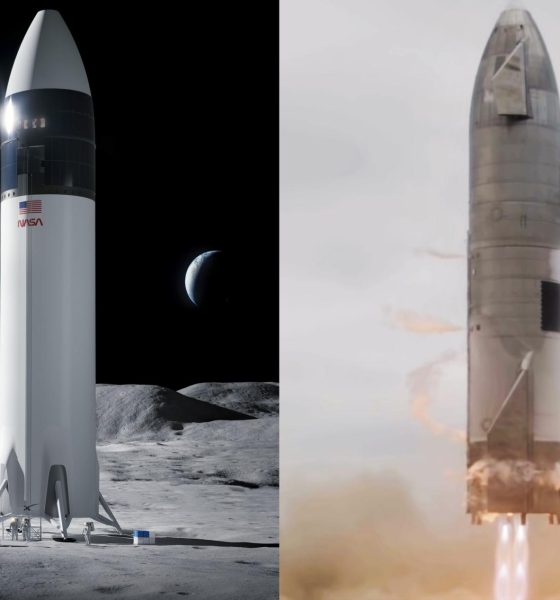

News
Blue Origin lawsuit forces SpaceX, NASA to stop joint work on Starship Moon lander
Days after Jeff Bezos space startup Blue Origin sued NASA over its decision to solely award SpaceX a contract to turn Starship into a Moon lander, it’s become clear that the space agency will again have to freeze work on the program.
Earlier this week, it was reported that Blue Origin had made good on a veiled threat to sue NASA over disagreements over the space agency’s latest Human Landing System (HLS) procurement decisions. Namely, NASA decided not to proceed with Blue Origin’s National Team Moon lander proposal, which was twice as expensive as SpaceX’s Starship proposal, less technically sound, and promised significantly less cost-sharing.
SpaceX, on the other hand, proposed to turn Starship into a safe, crew-rated, reusable Moon lander for about the same cost as Blue Origin’s proposal price: $6 billion, give or take. However, NASA says that the company offered to pay for more than half of the Starship Moon lander’s development, lowering NASA’s actual cost to just $2.9 billion. Coincidentally or not, $2.9 billion – with some minor concessions on when that funding would be dispersed to the HLS winner – would end up being almost exactly what NASA could afford over the program’s four to five-year lifespan.
As previously discussed on Teslarati, NASA repeatedly and explicitly warned all three HLS Option A competitors (SpaceX, Blue Origin, and Dynetics) that it withheld the ability to award as many or as few contracts as it wanted – including none at all. Ultimately, exactly as it had cautioned, NASA weighed the three proposals it received against its existing budget (a middling $850M of $3.4B requested in FY21) and selected just one – a proposal from SpaceX that was conveniently both the cheapest and most technically sound.
“The fixed-price [Starship] contract will cost NASA $2.9B over four or so years – narrowly within the space agency’s reach if Congress continues to appropriate around $850M annually ($3.4B over four years). The numbers are very simple. As GAO notes [in its protest denial], the Broad Agency Announcement (BAA) tool NASA used for its HLS Option A acquisition also explicitly allowed the agency to select as many or as few proposals as it wants, including none at all. In the lead-up to proposal submission, official NASA documents repeatedly cautioned as much, warning that the agency might not even award one contract depending on funding or the quality of proposals it received.
For Blue Origin’s lawsuit to succeed, the increasingly desperate company will have to convince a federal judge that basic realities and longstanding precedents of federal procurement – not just NASA’s HLS award to SpaceX – are flawed and need to be changed. The odds of success are thus spectacularly low. However, if the presiding judge allows the case to proceed and awards Blue Origin an injunction against NASA, it could force the space agency to cease work on SpaceX’s HLS contract for months and potentially freeze SpaceX’s access to the $300M NASA recently disbursed.”
Teslarati.com — August 16th, 2021
Unfortunately, just as speculated, Blue Origin’s lawsuit appears to have found just enough footing to disrupt the HLS program yet again. Thanks to the first protests of Blue Origin and Dynetics, NASA and SpaceX were forced to stop cooperative work on the Starship Moon lander for more than three months. Now, on August 19th, NASA reportedly “voluntarily paused” work on SpaceX’s HLS Moon lander contract and will continue to do so until November 1st – potentially adding another ~74 days to the 95-day delay Blue Origin’s meddling has already partially caused.
Schedule submitted jointly by all the parties today, and the judge’s order granting the schedule. pic.twitter.com/gyHS4R4j50— Joey Roulette (@joroulette) August 19, 2021
On its own, the announcement is already fairly bizarre. For unknown reasons, Blue Origin apparently agreed to “an expedited litigation schedule” in return for NASA voluntarily pausing work on SpaceX’s HLS contract. It’s unclear why any plaintiff that believes it has a strong case would allow an artificial limit to be placed on the amount of time available for litigation, but that’s exactly what Blue Origin has agreed to.
Per that “expedited schedule,” NASA’s voluntary work halt will end on November 1st after several scheduled rounds of motions and cross-motions from Blue Origin, SpaceX, and the space agency. It’s unclear when a ruling might be expected but the schedule published seems to imply that it would come sometime before NASA and SpaceX resume work.
It’s now increasingly likely that being forced to spend more than five months without the ability to seriously work or collaborate with SpaceX on its HLS contract will significantly delay NASA’s necessary contributions and thus humanity’s return to the Moon. Thankfully, as was the case with the initial 95-day delay caused by contract protests, no part of Blue Origin’s lawsuit will prevent SpaceX itself from continuing to develop Starship, though it almost certainly hampers the company’s ability to mature its Starship Moon lander design.
In the meantime, while Blue Origin busies itself with a general determination to disrupt NASA’s return to the Moon until it receives a slice of the pie its executives and owner feel entitled to, SpaceX will simply continue a full-court press towards Starship’s orbital launch debut and focus on building, testing, flying, and rebuilding the hardware that will return humanity to the Moon and, just maybe, revolutionize spaceflight as we know it.

News
Tesla FSD fleet is nearing 7 billion total miles, including 2.5 billion city miles
As can be seen on Tesla’s official FSD webpage, vehicles equipped with the system have now navigated over 6.99 billion miles.

Tesla’s Full Self-Driving (Supervised) fleet is closing in on almost 7 billion total miles driven, as per data posted by the company on its official FSD webpage.
These figures hint at the massive scale of data fueling Tesla’s rapid FSD improvements, which have been quite notable as of late.
FSD mileage milestones
As can be seen on Tesla’s official FSD webpage, vehicles equipped with the system have now navigated over 6.99 billion miles. Tesla owner and avid FSD tester Whole Mars Catalog also shared a screenshot indicating that from the nearly 7 billion miles traveled by the FSD fleet, more than 2.5 billion miles were driven inside cities.
City miles are particularly valuable for complex urban scenarios like unprotected turns, pedestrian interactions, and traffic lights. This is also the difference-maker for FSD, as only complex solutions, such as Waymo’s self-driving taxis, operate similarly on inner-city streets. And even then, incidents such as the San Francisco blackouts have proven challenging for sensor-rich vehicles like Waymos.
Tesla’s data edge
Tesla has a number of advantages in the autonomous vehicle sector, one of which is the size of its fleet and the number of vehicles training FSD on real-world roads. Tesla’s nearly 7 billion FSD miles then allow the company to roll out updates that make its vehicles behave like they are being driven by experienced drivers, even if they are operating on their own.
So notable are Tesla’s improvements to FSD that NVIDIA Director of Robotics Jim Fan, after experiencing FSD v14, noted that the system is the first AI that passes what he described as a “Physical Turing Test.”
“Despite knowing exactly how robot learning works, I still find it magical watching the steering wheel turn by itself. First it feels surreal, next it becomes routine. Then, like the smartphone, taking it away actively hurts. This is how humanity gets rewired and glued to god-like technologies,” Fan wrote in a post on X.
News
Tesla starts showing how FSD will change lives in Europe
Local officials tested the system on narrow country roads and were impressed by FSD’s smooth, human-like driving, with some calling the service a game-changer for everyday life in areas that are far from urban centers.

Tesla has launched Europe’s first public shuttle service using Full Self-Driving (Supervised) in the rural Eifelkreis Bitburg-Prüm region of Germany, demonstrating how the technology can restore independence and mobility for people who struggle with limited transport options.
Local officials tested the system on narrow country roads and were impressed by FSD’s smooth, human-like driving, with some calling the service a game-changer for everyday life in areas that are far from urban centers.
Officials see real impact on rural residents
Arzfeld Mayor Johannes Kuhl and District Administrator Andreas Kruppert personally tested the Tesla shuttle service. This allowed them to see just how well FSD navigated winding lanes and rural roads confidently. Kruppert said, “Autonomous driving sounds like science fiction to many, but we simply see here that it works totally well in rural regions too.” Kuhl, for his part, also noted that FSD “feels like a very experienced driver.”
The pilot complements the area’s “Citizen Bus” program, which provides on-demand rides for elderly residents who can no longer drive themselves. Tesla Europe shared a video of a demonstration of the service, highlighting how FSD gives people their freedom back, even in places where public transport is not as prevalent.
What the Ministry for Economic Affairs and Transport says
Rhineland-Palatinate’s Minister Daniela Schmitt supported the project, praising the collaboration that made this “first of its kind in Europe” possible. As per the ministry, the rural rollout for the service shows FSD’s potential beyond major cities, and it delivers tangible benefits like grocery runs, doctor visits, and social connections for isolated residents.
“Reliable and flexible mobility is especially vital in rural areas. With the launch of a shuttle service using self-driving vehicles (FSD supervised) by Tesla in the Eifelkreis Bitburg-Prüm, an innovative pilot project is now getting underway that complements local community bus services. It is the first project of its kind in Europe.
“The result is a real gain for rural mobility: greater accessibility, more flexibility and tangible benefits for everyday life. A strong signal for innovation, cooperation and future-oriented mobility beyond urban centers,” the ministry wrote in a LinkedIn post.
News
Tesla China quietly posts Robotaxi-related job listing
Tesla China is currently seeking a Low Voltage Electrical Engineer to work on circuit board design for the company’s autonomous vehicles.

Tesla has posted a new job listing in Shanghai explicitly tied to its Robotaxi program, fueling speculation that the company is preparing to launch its dedicated autonomous ride-hailing service in China.
As noted in the listing, Tesla China is currently seeking a Low Voltage Electrical Engineer to work on circuit board design for the company’s autonomous vehicles.
Robotaxi-specific role
The listing, which was shared on social media platform X by industry watcher @tslaming, suggested that Tesla China is looking to fill the role urgently. The job listing itself specifically mentions that the person hired for the role will be working on the Low Voltage Hardware team, which would design the circuit boards that would serve as the nervous system of the Robotaxi.
Key tasks for the role, as indicated in the job listing, include collaboration with PCB layout, firmware, mechanical, program management, and validation teams, among other responsibilities. The role is based in Shanghai.
China Robotaxi launch
China represents a massive potential market for robotaxis, with its dense urban centers and supportive policies in select cities. Tesla has limited permission to roll out FSD in the country, though despite this, its vehicles have been hailed as among the best in the market when it comes to autonomous features. So far, at least, it appears that China supports Tesla’s FSD and Robotaxi rollout.
This was hinted at in November, when Tesla brought the Cybercab to the 8th China International Import Expo (CIIE) in Shanghai, marking the first time that the autonomous two-seater was brought to the Asia-Pacific region. The vehicle, despite not having a release date in China, received a significant amount of interest among the event’s attendees.








